What is coronary artery bypass graft surgery?
Coronary artery bypass surgery (also called coronary artery bypass grafting or CABG) is used to restore blood flow to the heart by re-routing blood around blocked coronary arteries.
Who needs coronary artery bypass graft surgery?
Coronary artery bypass surgery is a treatment for patients with coronary artery disease (CAD). Your doctor will order tests to learn more about your CAD. The test results, along with details about your heart structure and function, your age, your symptoms, other medical conditions you have and your lifestyle will help your doctor determine if CABG is a good treatment option for you.
At Cleveland Clinic, bypass surgery is often performed along with other heart surgeries you may need, such as valve surgery, aortic aneurysm surgery or surgical treatment for atrial fibrillation (an abnormal heart beat).
Coronary artery disease is the narrowing or blockage of the coronary arteries caused by atherosclerosis. Atherosclerosis (sometimes called “hardening” or “clogging” of the arteries) is the buildup of cholesterol and fatty deposits (plaque) on the inner walls of the arteries that restricts blood flow to the heart.
Blockage of one or more coronary arteries can cause a heart attack (injury to the heart muscle).
Coronary arteries
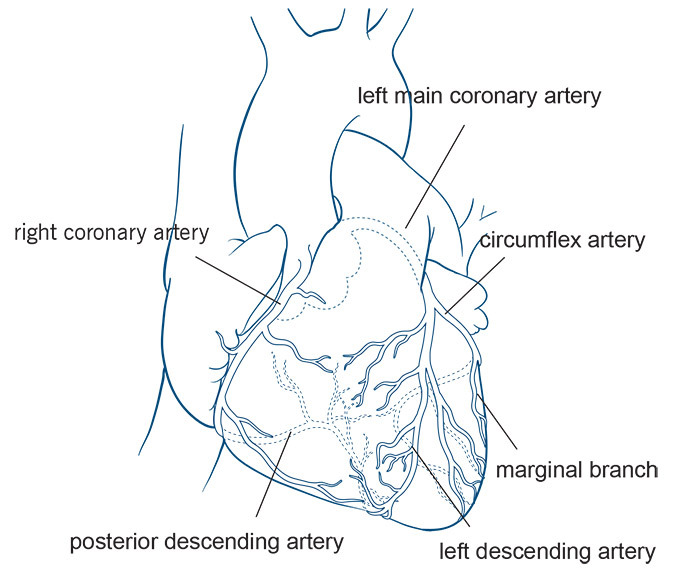
What can I expect before coronary artery bypass graft surgery?
If you are scheduled for CABG, you will get details about how to prepare, including changes to your medications, eating and drinking and other information.
What happens during coronary artery bypass graft surgery?
Coronary artery bypass surgery uses healthy blood vessels, called grafts, to create detours for blood flow around the blocked coronary arteries. The grafts usually come from your own arteries and veins in your chest, leg or arm.
It is common for more than one artery to be blocked — many times three or four. All of these arteries can be bypassed at one time.
Types of Grafts Used for CABG Surgery
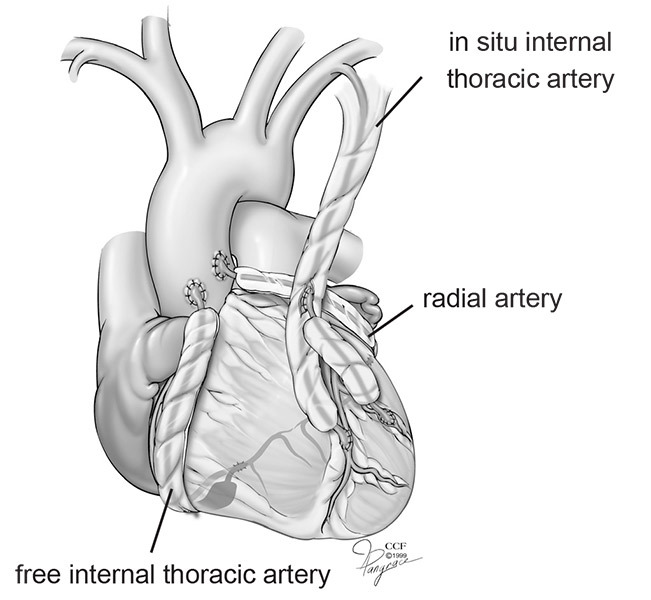
There are several types of bypass grafts. The type used depends on the size of your coronary arteries, the blockage (where it is and how bad it is), your age and other health problems you have.
The grafts are put in place by sewing one section around a tiny opening just below the blockage in your coronary artery and attaching the other end to a small opening made in your aorta. This redirects the blood flow around the blocked area. If an internal thoracic artery is used, one end stays attached and the other end is attached to the aorta.
Grafts can come from arteries or veins. Arteries are preferred over veins because they last much longer. Your surgeon will talk to you about the types of grafts that are best for you. But, in general, Cleveland Clinic surgeons use arterial grafts whenever possible.
Arterial grafts (created with arteries)
- Internal thoracic arteries (ITA grafts/internal mammary arteries [IMA]) are the preferred and most common bypass grafts used. They have the best long-term results. You have two ITAs in your chest. Most times, these arteries can be kept intact at one end because they have their own oxygen-rich blood supply. The other end is cut and sewn to the coronary artery below the blockage. If the surgeon completely removes the artery and uses it as a graft, it is called a free artery.
Types of Thoracic Bypass Grafts
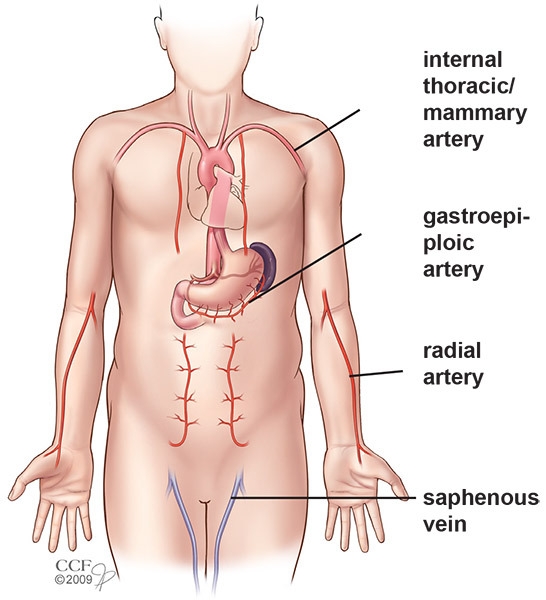
- The radial (arm) artery is another common type of arterial graft. There are two arteries in the arm — the ulnar and radial arteries. The ulnar artery also delivers blood to the arm, so most people don’t have side effects if the radial artery is used as a graft. If your surgeon decides to use your radial artery, you will have tests before and during surgery to make sure this is the best option. You will likely need to take a calcium channel blocker medication for several months after surgery to help keep the artery open. If the radial artery is used, your wrist may be numb after surgery. This feeling usually goes away.
- The gastroepiploic artery is a branch that leads to the stomach. The inferior epigastric artery leads to the abdominal wall. These arteries are harder to use. But, they offer a good option if other arteries cannot be used as grafts.
Vein grafts
- Saphenous veins are in your legs. The veins may be removed with a minimally invasive technique. This is done by making one or two short incisions in your knee area, and a small incision in your groin. This technique causes less scarring and a faster recovery than traditional surgery to remove the veins. Although there has been a lot of work done to improve the results when vein grafts are used, they still tend to fail in the long term.
What can I expect during coronary artery bypass graft surgery?
The surgery usually takes 3 to 5 hours, depending on the number of arteries being bypassed. You will get general anesthesia (be “asleep”) for the surgery.
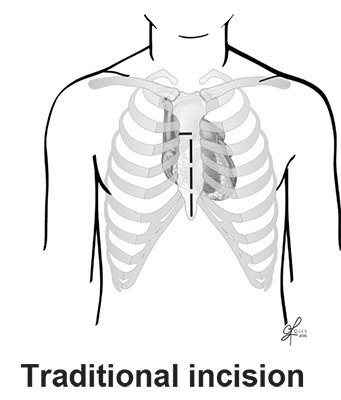
The first step is for the surgeon to get the grafts ready. Then, the surgeon will make an incision (6 to 8 inches) down the center of your chest, cutting through your breast bone (sternum). The benefits of minimally invasive surgery include a smaller incision (3 to 4 inches) and scars. Other possible benefits, compared with traditional CABG surgery, may include a reduced risk of infection, less bleeding and trauma, and a shorterhospital stay (3-5 days) and recovery.
You will likely be on a heart-lung machine so the surgeon can operate on a still heart. This is called “on-pump” surgery. The machine takes over for your heart and lungs so blood keeps moving throughout your body. The machine is turned off after the grafts are sewn into place and your heartbeat and blood flow return to normal. The surgery can sometimes be done without the heart-lung machine (off-pump surgery). Your surgeon will talk to you about the best surgery options for you.
Temporary pacing wires and a chest tube will be put in place before your sternum is closed with special wires. Your incision will be closed with stitches (internal or external). The pacing wires are used in case you have an abnormal heart rhythm after surgery, which is not uncommon. The wires are attached to a temporary pacemaker until your heart rhythm is normal again. The chest tube is used to drain fluid as you recover. The pacing wires and the chest tube will be removed as soon as it is safe to do so.
Minimally invasive technique
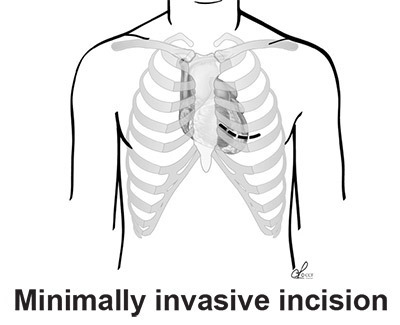
Minimally invasive coronary artery bypass graft surgery is not an option for every patient. It may be an option if you need a left internal mammary artery bypass graft to your left anterior descending artery. Your doctor will let you know if a minimally invasive procedure is an option for you.
Other minimally invasive surgery techniques include endoscopic or keyhole approaches (also called port access, thoracoscopic or video-assisted surgery) and robotic-assisted surgery.
The benefits of minimally invasive surgery include a smaller incision (3 to 4 inches) and scars. Other possible benefits, compared with traditional CABG surgery, may include a reduced risk of infection, less bleeding and trauma, and a shorter hospital stay (3-5 days) and recovery.
How will I feel after surgery?
It will take about 2 months to fully recover from CABG surgery. It may take less time if you had minimally invasive surgery. At first, you may have more pain and shortness of breath than you did before the surgery. This is normal and usually related to the trauma of the surgery and not how well your heart is working. These symptoms will disappear over time.
What can I expect during my recovery from coronary artery bypass surgery?
You will get detailed information about your recovery, including activity, driving, returning to work and when to call your doctor.
It is very important to join a cardiac rehabilitation (rehab) program. You will start working with a cardiac rehab specialist while you are in the hospital. Continuing rehab after you go home will help your recovery and reduce your risk of future heart problems.
What type of follow-up do I need after coronary artery bypass surgery?
Follow-up care is an important part of your recovery. Patients who have heart surgery at Cleveland Clinic see their heart surgery team a few days after they leave the hospital. You will also need to see your cardiologist or primary care doctor within the first month after surgery, and again 6 to 8 weeks after surgery. Your doctors will make sure you are taking the right types and amounts of medication and that your recovery is on track.
Keep your follow-up appointments with your cardiologist, even if you feel well. You should be seen once a year or as often as your doctor recommends. You may also need regular testing, such as an echocardiogram.
Call your doctor if your symptoms get worse or happen more often. DO NOT wait until your next appointment to talk to your doctor about changes you notice.
What are the benefits of coronary artery bypass surgery?
Coronary artery bypass surgery will help:
- Relieve your symptoms of CAD, such as angina (chest discomfort) and shortness of breath.
- Get you back to your normal lifestyle and activities.
- Lower your risk of a heart attack and other heart problems.
How you feel after surgery depends on your overall health, the results of the surgery, how well you take care of yourself after surgery and how well you felt before surgery. It is very important to follow your doctor's advice about lifestyle changes, follow-up care and medications. Doing so will help you get the most benefits from your surgery and help you avoid future heart problems.
What are the risks of coronary artery bypass graft surgery?
As with any surgery, CABG surgery involves risks. Your risks are based on your age, other medical conditions you have and the number of procedures you have in a single operation. Your surgeon will talk to you about your risks before your surgery. Please ask questions to make sure you understand why the procedure is recommended and what all the risks are.
What types of lifestyle changes do I need to make after surgery?
Coronary artery bypass graft surgery increases the blood supply to your heart, but it does not cure CAD. Making lifestyle changes help reduce your risk of future heart problems.
These changes include:
- Not smoking or using tobacco/nicotine.
- Managing your cholesterol levels.
- Managing high blood pressure and diabetes.
- Getting regular exercise.
- Reaching and staying at a healthy weight.
- Eating a heart-healthy diet.
- Managing stress and anger.
- Taking all medications as directed.
- Joining a cardiac rehab program.
- Seeing your doctor for regular follow-up visits.